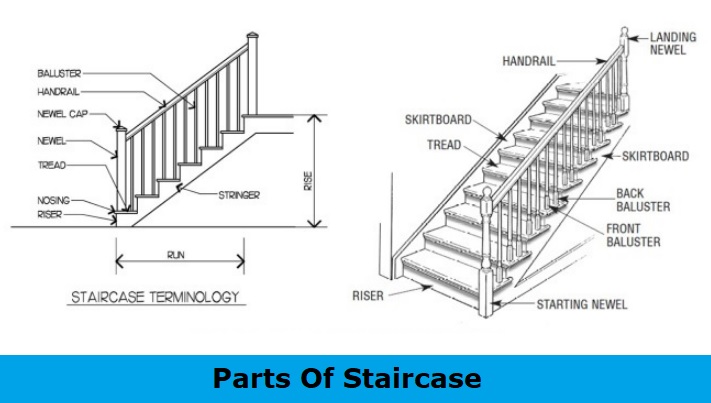The staircase is a very important component of a building. Every building has at least one staircase to access the roof. The staircase is used to shift from one floor to other floors in the building.
A staircase consists of various parts or components. In this article, I will discuss all the key components of a staircase.

Here are the complete description of staircase components.
Table of Contents
1. Step:
The step consists of a riser and tread. We walk on steps. It allows ascent & descent from one floor to another.
2. Tread:
Tread is the horizontal part of the step. The foot is placed on the tread during ascending or descending.
3. Riser:
The riser is the vertical member of the step. The main work of the riser is to support and connect successive treads.
4. Rise:
Rise is the vertical height between two consecutive treads.
5. Landing:
Landing is a horizontal step that connects floor and flight. It is used to change the direction of the flight. The area of one landing is normally bigger compared to one step. Landing ensures a safe transition between floor and flight.
6. Nosing:
It is the projecting portion of the tread beyond the face of the riser. Nosing provides more comfort while walking on the staircase. Nosing is made rounded to give a good aesthetic effect to the treads and make the staircase convenient and easy to use.
7. Going:
The horizontal distance between one nosing to another nosing is known as going.
8. Flight:
A set of steps between one floor or landing and the next is known as flight.
9. Head Room:
The vertical stature between the tread of one flight and the slab of the overhead construction is known as headroom. The headroom ought to be adequate so as not to make any trouble to the people utilizing the stair. Headroom is otherwise called headway.
10. Handrail:
As we all know handrail a little bit. It is normally inclined rail provided at a suitable height over balustrades. Rail inclination is parallel to the slope of the stair.
The handrail works as a guard rail and assists users of the stair.
11. Baluster:
A baluster is an individual vertical member made of timber, glass, metal, or masonry and fixed between string and handrail to provide support to the handrail.
12. Balustrade:
The balustrade is a combination of various balusters and handrails. Sometimes it is called a barrister.
13. Pitch or Slope:
Pitch or slope is the vertical angle made by the nosing line of the stair with the horizontal plane.
14. Run:
The aggregate length of the stair in the horizontal plane including lengths of landings is known as the run of the stair.
15. Soffit:
The undersurface of the stair is called a soffit. It is either finished with mortar or covered with a ceiling.
16. Scotia:
Scotia is a type of additional molding provided under the nosing or tread to increase the aesthetics of the step of elevation.
